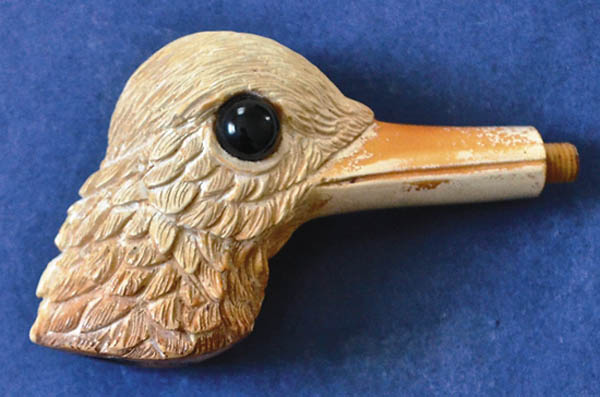Meerschaum Pipes
Fooled By Fakes
Meerschaum pipes are made in two ways: from block meerschaum or pressed meerschaum. Block meerschaum, when solid blocks of meerschaum are hand carved into pipes, is considered preferable both for smoking and collecting. Pressed meerschaum, which is much less expensive than block, is made from leftover meerschaum dust, shavings and chips. These pieces are then bonded together with an adhesive. A third type of pipe being passed off as meerschaum by some sellers is made of resin and doesn't contain any meerschaum pieces at all. Meerschaum collectors and smokers classify these fakes as "meersham," though some aficionados also put pressed meerschaum in that category. Whether or not to include pressed meerschaum in the category of "fakes" is contested among members of the meerschaum community.
Pressed resin pipes began being made in the 1970s and are sometimes misrepresented and sold as meerschaum. The person responsible for first making them didn't call them meerschaum, but rather sold them with the name "hydrostone." He used his own antique meerschaum pipes to make the molds, so the shapes and depictions are more convincing, since the subject matters and carving would be in keeping with authentic pipes from other time periods. Three of these pieces have been reported by Pipes Magazine (pipesmagazine.com); a Viking or Norse bust, a woman with outstretched arms called "Nude Victory," and a woman and child. Some indications that these pipes are not meerschaum include incorrect shank configurations, a lattice pot metal shank band (seen on the Viking pipe), or a push stem that is configured wrong for an antique pipe. Some pressed resin pipes may have a seam, which would obviously indicate a fake, block meerschaum is carved out of a solid piece and would never have a seam. A resin pipe may also be pre-colored to imitate the warm golden or brownish hue that develops in a real meerschaum pipe. These colorings may appear a bit off.
Pressed meerschaum pipes are typically heavier that lightweight block meerschaum, and you may see multiples of the exact same piece with no variations. This could occur with resin pipes as well. Since block meerschaum is hand-carved, no two will be exactly identical. One of the tests that meerschaum collectors use is to apply a small bit of moisture from your fingertip to the pipe; block meerschaum will absorb it, while resin pipes won't absorb moisture, and pressed meerschaum either won't absorb or will absorb moisture at a much slower rate.
Gustav A. Fischer was a respected meerschaum pipe artisan, one of several generations of pipe makers in the "House of Fischer" (there is a lot of confusion and misinformation about this family's history in pipe making, but more can be read in the online "Masters of Meerschaum" article in Pipes and Tobaccos Magazine (https://pipesandtobaccosmagazine.com/2012/09/fischer-whos-who/). His carvings were extremely intricate, ranging from detailed faces of famous people to animals and entire scenes. One of his most famous pieces is a large meerschaum pipe depicting the Battle of Bunker Hill, complete with 25 soldiers. At the time of its completion in 1905, it was said to be the most valuable pipe in the world, valued then at $40,000, which would convert to a value of over $1 million today. Many experts say that Gustav A. Fischer never signed any of his pipes, but at least one well-known, high-end auction house sold a pipe with a Gustav Fischer signature for over $1,000. Therefore, with such conflicting information, a Fischer signature should at least raise a flag of caution to buyers.
Some meerschaum pipe artisans were known to sign their creations with their marks or signatures carved into the pipe itself, but not all of them did. Also, pipe company labels were sometimes added to or imprinted inside fitted pipe cases, or their names may be impressed into the outside of the hard case or in the pipe stem. Obviously, it's possible that someone could have replaced an original pipe with a newer or pressed meerschaum pipe that happens to fit in an original marked case, so don't make a final judgment just based on the case or the label. However, you can check the labels, impressed marks and especially the carver's signature against known authentic pieces; one online resource for this is Pipe Phil (http://pipephil.eu/logos/en/nonbriar/meer.html), which has marks, logos, and more for many different types of pipes.
Although some guides suggest dating a meerschaum pipe or determining whether it's block versus pressed according to the material used for the mouthpiece, that's not always a true way to evaluate a pipe, especially if you're buying online. Mouthpieces can be replaced, creating "marriages" of old and new as well as combining materials that may not originally have been from the same time period or the same artist or company. Lucite, clay, and amber were among the materials used in old mouthpieces, but you wouldn't have seen the solid yellow plastic mouthpieces used on some cheaper pipes today.
Comparing notes and asking questions of fellow meerschaum collectors is a great way to refine your knowledge of meerschaum pipes and get opinions as to authenticity. You can find a couple of online forum resources in the reference section below.
All photos property of the author.
At A Glance
Signs of a fake:
1. Seam along pipe bowl.
2. Gustav A. Fischer signature warrants authentication.
3. Uncolored veins in used meerschaum indicates pressed.
Reference books, websites, and collecting groups are the best ways to keep from being fooled by fakes. Here are a few: Collecting Antique Meerschaum Pipes: Miniature to Majestic Sculpture by Ben Rapaport; The Antique Meerschaum Pipe Museum (Facebook page): https://bit.ly/2UICDfA; online forums: Pipes Magazine: http://pipesmagazine.com/forums; Puff.com: www.puff.com/forums.










